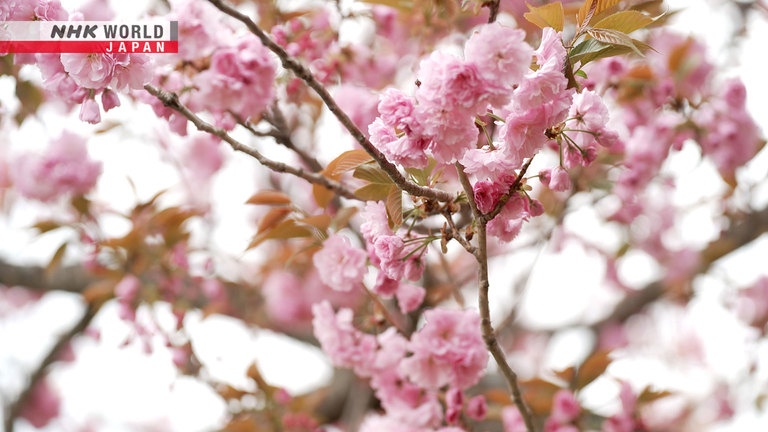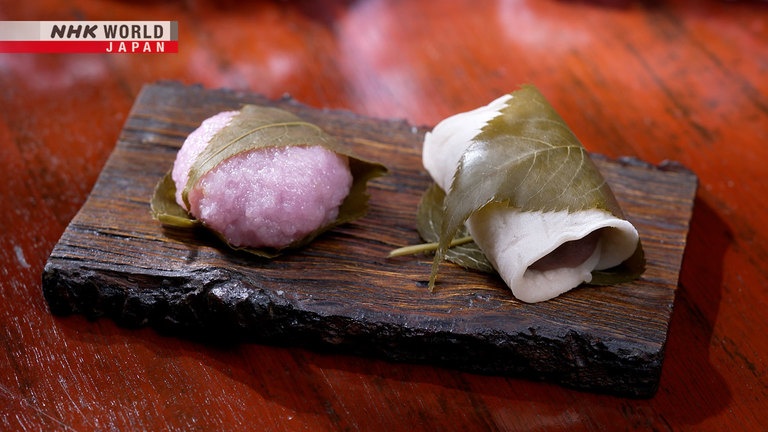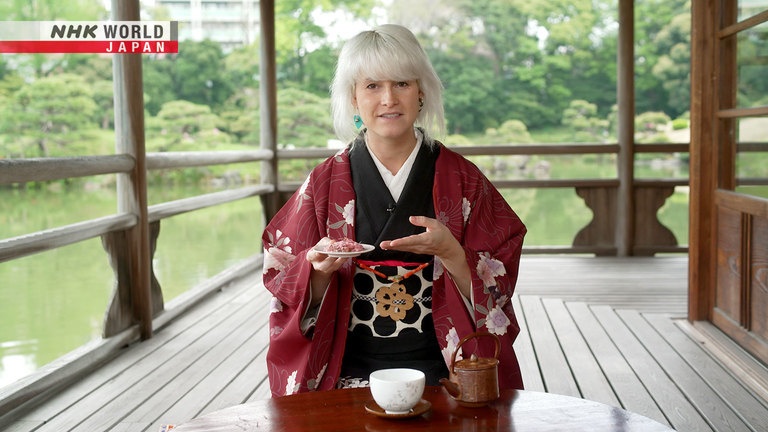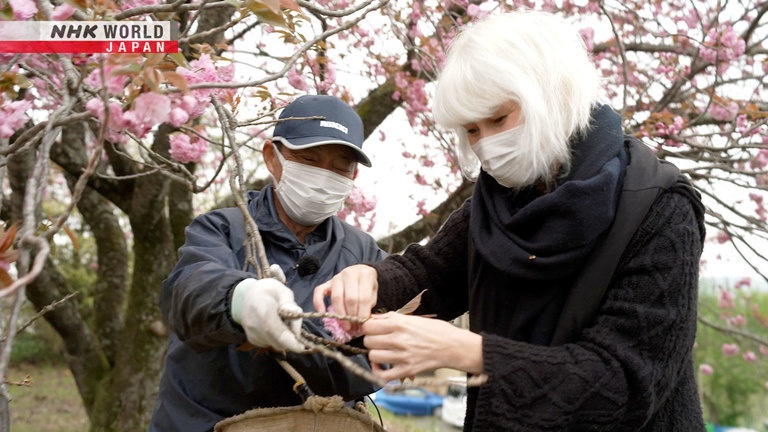SAKURA
Sakura—the beloved cherry blossoms that symbolize the coming of spring in Japan. More than just eye candy, the blossoms and leaves are also salted and consumed. Sakura farmers scramble up trees to collect the best ones before everything falls to the ground. Reporter Saskia lends a hand before visiting a 300-year-old sweets shop depicted in woodblock prints to find out more about the flower's culinary roots. She also meets an individual responsible for the popularization of sakura as a flavor. (Reporter: Saskia Thoelen)




Transcript
Tokyo: this world-class metropolis is a veritable gourmet wonderland.
Discover the stories behind the ingredients that make this city so delicious - so "oishii."
Hi. I'm Saskia from Belgium, and today's theme is "sakura!"
In Japan, spring is sakura season.
They're known to the world as cherry blossoms.
The flowers have had a profound place in Japanese culture for centuries.
They're so lovely, you could just eat them up.
Literally!
They've been salted and consumed for centuries.
The essence of spring can be enjoyed in the form of tea.
Savory.
"Sakura mochi" rice cake also marks the arrival of spring.
Aside from traditional favorites, new sakura-flavored delights make their way into shops every year.
The Japanese have been loving sakura for centuries - - not only through their eyes, but apparently also through their mouths.
I'm about to find out what that means concretely.
Trails to Oishii Tokyo.
Sakura - Japan's symbolic flower.
It's remained close to the hearts of the Japanese for ages.
Cherry blossom viewing, called "hanami," dates back nearly 1,000 years.
When spring arrives, people travel far and wide to revel in their beauty.
What makes sakura so important?
More than just a pretty flower, they are seen as a symbol of the fleeting nature of life.
There are a lot of flower species that are eaten all over the world.
For example, in Belgium, we eat violets, and we even make them into small candy.
But I was actually really surprised to hear that sakura are eaten too.
So, here I am in the middle of sakura blooming season ready to pick some sakura.
Hadano, Kanagawa, is the largest producer of edible sakura.
Sakura trees were planted for consumption starting around the end of the Edo period, apparently to raise money for local festivals.
In Hadano, April is a busy time for sakura growers.
They're picking them!
- Good morning!
- Welcome.
Thanks for having us.
Ono Takayoshi usually grows carnations, but once a year his focus shifts to sakura.
His are a double-flowered variety called "kanzan" cherry.
They have more petals and a darker pink color than other types.
They look beautiful when dried and give off a wonderful fragrance when processed.
These trees are ready for picking.
- They're right at the 80% mark.
- 80%?
That's when a tree is made up of
80% blossoms and 20% buds.
Both petals and buds are used to make goods.
We have to pick the best trees for that.
He goes for the trees that are 80% in bloom.
This ensures the petals are firmly intact even after processing.
We pick these blossoms by hand.
By hand? How?
Pull it from the bottom, towards the tree,
and it comes off easily.
- Try picking one.
- Here?
- This way?
- It's difficult that way.
- Ah I see. That's much easier.
- Right.
Now I got it.
There you go.
First time?
Yes, but my mom had a flower shop,
so I'm used to handling flowers.
I see. But not picking?
Not at a flower shop, no!
I wouldn't think so.
- Pick everything?
- We can't pick the leaves.
Why not?
Flowers will sprout from here next year.
These flowers are blooming on
a branch from last year.
If we pick the leaves, this branch
won't grow flowers next year.
- That would be the end of it.
- Right, so we don't touch the leaves.
- I'll be careful.
- Keeping that in mind, please pick a lot.
Continue here.
The window of opportunity for trees that are 80% in bloom is about three days.
During the blooming process, they're located as quickly as possible one after the other.
It's a race against time.
To make sure I get to them all,
I pick them like this.
Grab it all like this, and pull.
That's quick!
The high-speed technique is the product of decades of experience.
This way, farmers can collect up to 70 kilos in one day.
Saskia's sent up a ladder to fetch more.
Hook the safety belt there.
Same as what you did before.
Dedicated work done in stunning surroundings.
All I see is pink. I'm so happy.
We start from the top.
At that point, there's flowers all around you.
I feel like I'm one of them.
- I feel true happiness.
- Me too. It's great.
Surrounded by flowers.
It's sad they get taken down little by little.
Yeah. But that's my job.
True.
Sakura are very beautiful.
For me, they're fun to look at
because the color is so striking.
What do you feel when you see sakura?
A tree with lots of flowers fills me with delight.
There's work involved, but it's also exciting.
We see a blooming tree and think, "oishii."
Sakura peak season lasts about two weeks.
Sadly, that means spring is coming to an end.
The harvested blossoms are sent off to pickle processors.
They're mixed with salt and plum vinegar and left for about a month.
The result?
Savory pickled sakura, ready to eat.
The simplest way to enjoy them is in tea form.
This is pickled sakura from last year.
Take one sakura and lightly brush off the salt.
Put it in the teacup.
Then pour in the warm water.
And we have sakura tea.
The petals are opening up.
In full bloom once again. Lovely.
"Itadakimasu."
A bit salty.
But that's followed by a nice sweetness.
It almost has a spice to it. Not like cinnamon,
but something like that. I guess it's the sakura.
The light sweetness creates a wonderful balance.
Sakura tea is served at celebrations like weddings and graduation ceremonies.
The flower opening in the water symbolizes good fortune and a prosperous future.
Now for some "sakura anpan."
Anpan are milk rolls with a sweet "azuki" red bean filling.
Pickled sakura is added for a refreshing burst of flavor.
The spring specialty making use of the local sakura, so I would really like to make that right now.
So let's get started.
We have here pickled sakura. So, we're gonna use this.
The sakura is soaked to remove salt.
Ono-san told us that it's best to not take out too much salt, so let's be careful with that.
After a few minutes, remove it from the strainer and chop it up.
This is "sekihan" - sticky rice with azuki beans.
The finely-chopped sakura is mixed in to make "onigiri" rice balls.
What's important right now is that you really want to make sure that your rice is not too hot, because if it's too hot the sakura will change color -
they will lose their pretty pink color and turn brown.
So you really want to make sure that the rice is cooled down.
Okay, so we're done mixing now and we're going to make them into "onigiri."
You want to make this cute, triangular shape.
Look at that. So cute.
And now, we're done.
Festive "sekihan" rice balls adorned with lovely sakura.
Oh, this is really good.
You have this... a bit of saltiness of the sakura and then the sweetness of the beans together with the structure of the rice,
it's so good. I really love this.
Sakura isn't all about the petals though.
You can eat the leaves too!
In Matsuzaki, Shizuoka, the largest producer, you'll find dedicated fields for cultivating sakura leaves.
The type of tree used to grow edible leaves is the Oshima cherry.
Its leaves have a nicer texture, being less hairy, and are taken from younger trees while extra soft.
They're pickled in salt for six months and mainly used as a garnish for Japanese sweets.
There's a traditional sweet
that uses sakura leaves.
It's called "sakura mochi."
"Sakura mochi," a sweet with a red bean filling called "anko," is often wrapped with a sakura leaf.
The leaf offers a nostalgic fragrance that's been cherished for generations.
A shop in Mukojima, Tokyo, is said to have been the first to make "sakura mochi."
The nearby Sumida River is a famous sakura spot.
- Hello.
- Welcome.
- Thank you for having us.
- My pleasure.
I heard this is where "sakura mochi"
was first made. When was that?
Over 300 years ago, in 1717.
Sakura were being planted along the river,
leaving behind a lot of leaves.
Thinking of ways to put them to use,
the idea for "sakura mochi" came about.
After Shogun Tokugawa Yoshimune planted sakura along the Sumida River, the area soon became famous for "hanami," or cherry blossom viewing.
Wanting to find a way to cater to the influx of visitors, the shop began incorporating sakura leaves.
Where did the idea of pickling
leaves in salt come from?
The shop founder, Yamamoto Shinroku,
was from Choshi, Chiba.
He put leaves in some soy sauce barrels.
Soy sauce production in Choshi dates back to the 1600s.
It's said the shop founder began storing sakura leaves in soy sauce barrels.
This idea led to the invention of "sakura mochi," which quickly took Edo by storm!
It says "sakura mochi."
Yes. "Specialty, sakura mochi, Yamamoto Shinroku."
Oh! That's your shop!
The shop is depicted in "ukiyo-e" woodblock prints.
A woman is seen eating "sakura mochi" while carrying some in bamboo baskets.
One of the women is said to be Shinroku's granddaughter, Otoyo.
- How many generations?
- I think it's 11 now.
- That long?
- Yes.
Wow!
- Do you make anything other than "sakura mochi?"
- No.
- Only "sakura mochi?"
- That's right.
Their recipe has remained the same for 300 years.
How does it taste?
Thanks for waiting.
Here's the "sakura mochi."
Thank you. How nice!
The leaves are covering the mochi for
added fragrance and to keep it moist.
Remove the leaves and enjoy.
Some people eat it as-is.
The leaves are edible.
But I recommend removing them.
"Itadakimasu."
"Oishii."
It's...
So you have the "anko" that comes in at first, and then the soft texture of the crepe.
Like, the flavor and the scent of the sakura leaf that comes in, it's so good.
The balance is so good. But it's so good. The balance is...
It's so lovely. I love it.
A feast for the eyes, nose, and taste buds.
"Sakura mochi" allows you to get the most out of every sakura experience.
You see lots of sakura-colored sweets
for sale in spring in Japan.
Everything from chocolates to cakes.
Even a sakura-flavored Mont Blanc.
Everything is sakura.
Let's try the Mont Blanc.
Delicious. It's sweet, but
the sakura flavor is refreshing.
There is a touch of spice, like cinnamon,
but different. It's hard to explain.
Sakura is a difficult flavor to explain.
Just as they come in different shades,
they're also not just sweet and savory.
It's hard to describe in simple terms.
Saskia meets with a man who helped kickstart the sakura flavor trend.
Thank you for your time today.
Hirade Makoto is an ingredients wholesaler that caters to confectioners.
Of course, he sells sakura petals and leaves too.
He spearheaded a sakura flavor movement about 20 years ago.
Many sweets are sakura-flavored, but how?
Is it artificial?
For us, it's all about using real petals and leaves.
The leaves have fragrance, and the petals
have fragrance and flavor components.
Pickling them in salt brings all of that out.
Salt activates an organic compound called coumarin, which gives sakura treats their unique aroma.
So, you use real flowers and leaves?
That's right.
How did that start?
A pickled leaf supplier in Shizuoka
had more than they could sell.
I wanted to think of a way to help out.
So, we started using them to make various products.
Pickled sakura leaves were minced.
Salt was removed from pickled flowers, and sugar was added.
And a sakura extract packed with coumarin becomes the base sakura flavor.
A long-established Japanese confectioner created a "yokan" jelly dessert using Hirade's new flavoring.
This led to more and more sakura-flavored treats popping up across the country.
The "yokan" jelly dessert contains minced sakura leaves.
"Oishii."
A strong sakura flavor.
Aroma of the leaves, right?
Like with "sakura mochi."
Sweet, not salty. It's quite refreshing.
It's a long-selling item. We've been
selling it for over 20 years now.
I can see why. "Oishii." Very tasty.
Sakura flavoring has spread beyond traditional sweets.
In spring, sakura treats line the shelves in cafes and convenience stores.
Now that I know more about sakura,
I'd like to use it in Belgian sweets.
I'll start with cookies and then make
everyone's favorite, Belgian waffles.
Original recipes by Saskia, a Belgian herself.
She begins with cookies.
Mix the ingredients together.
Let the heat from your hands melt the butter as you mix.
Don't over-melt the butter, so the cookies stay moist and crispy.
When it's nice and sticky, it's done.
Let's add some sakura leaves. Just a bit.
This is my mom's recipe.
It's been a while. A bit nostalgic.
Leave space between them
because they'll enlarge as they bake.
Next, world-famous Belgian waffles.
Add melted butter to the flour.
Two eggs.
Some sakura extract.
It's not rocket science. Just mix it up.
It's stickier than pancakes.
Time to put the batter in the waffle maker.
Everyone in Belgium has a waffle maker.
You'll find one in every household there.
Waffles are a common snack.
Most families do it a similar way,
but this is basically a family recipe.
One sakura leaf on top.
Let's close it up.
All done!
Look how cute they look!
Belgian delights meet Japanese sakura in sweet, sweet harmony.
I didn't think they'd turn out this nice.
I'm very pleased.
Let's give them a try.
This has minced sakura leaves.
It's a lot like "sakura mochi."
Nice and refreshing. "Oishii!"
One added ingredient really changes things!
It's a whole new world.
I'll try the Belgian waffle next.
"Oishii!"
So nice.
A familiar flavor with the tasty
addition of savory sakura.
I could smell the leaf as soon as
I opened the waffle maker.
There's a sweet and savory balance
similar to "sakura mochi."
You don't need a sweet tooth to love this.
Sakura waffles need to be a global thing!
I'd always loved sakura, but didn't know
much about it as an ingredient.
I'm happy to have learned more on this journey.
Trying sakura in some familiar Belgian sweets
was a refreshing experience for me.
I realized sakura is much more
than just a feast for the eyes.
In Tokyo, every ingredient has its own story.